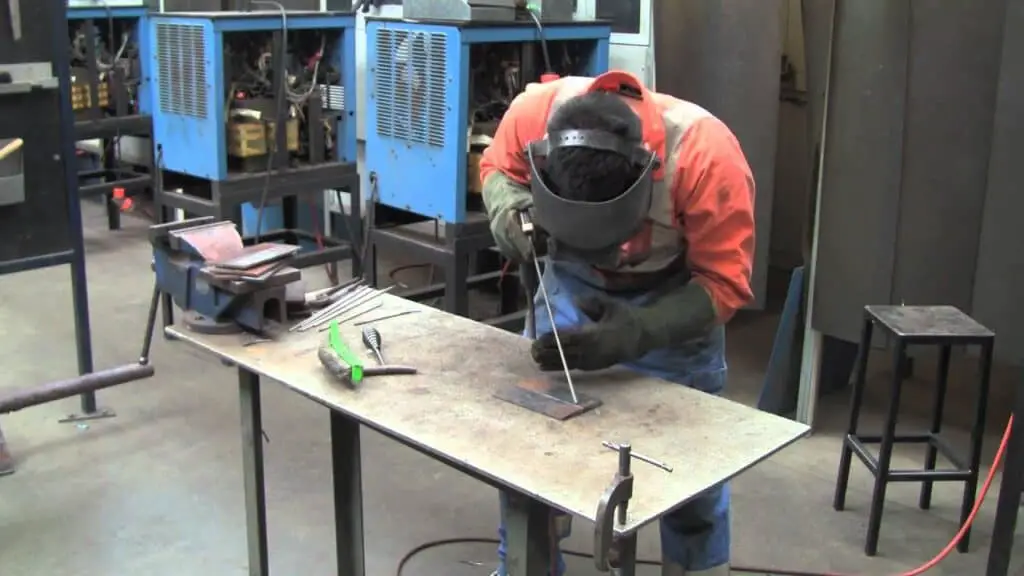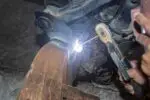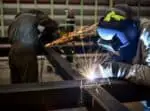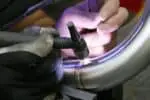You will very well be knowing how a welder needs to weld different objects on different plains. Well, this is exactly what the different positions like 1G, 2G, etc denotes.

The 1G position is used wherever the welder gets to weld in a horizontal position. Here, ‘1’ means flat and ‘G’ means the Groove. There are instances when this position is not desirable depending upon the pieces welded.
In 1G welding position the face of the welder will be directly above, and, gun and electrode are placed perpendicular to the joint. It is therefore also called a ‘downhand position’.
So as long as the welding pieces (during and after being welded) have a surface where they can be laid horizontally, 1G position becomes the most efficient method to get it done.
As mentioned earlier, there are instances where 1G is not suitable; this is when the things to be welded after being assembled cannot be repositioned in the way you want. They need to be placed vertically or overhead while being welded as they need to stay in that position forever.
What are the benefits of using 1G position for welding?
1. Safest
As 1g is the horizontal position of welding, the hot fluid stays inside the weld pool, and therefore, it is the safest position of welding.
You don’t have to be extra cautious here as you can see how fast and in which direction the fluid moves. Your face is directly above the welding area and therefore you can keep a safe distance from it and move away quickly if you want to.
2. Less tricky
As the position is the most basic one, the working is pretty simple and therefore there is not much that you need to learn. The simple positioning of 1G makes it the most basic knowledge of welding position for a welder. A person possessing a qualification of just 1G positioning, therefore, will not create much demand for him.
3. More effective
As 1G works along with the gravity, the electrode penetrates stronger than when it is done in 2G or any other position for that matter. You get better precision works with 1G.
4. Faster
1G is preferred by many not just because it is the safest and easiest position to weld but also because it is the faster way of welding too. Yes, it is true. Just think like this. Would it be easier to write on a book placed on a table or one that is hung on a wall?
As mentioned earlier the hot fluid stays in the joint and does not drip, making it easier to manage the process. The better the way you deal with the process, the faster you finish it.
5. Lesser skill set will do
That’s right. A person who is having beginner-level knowledge of welding can undertake 1G welding as it is not complicated and convenient to do. Whereas for other positions like 2G and above, the skill requirement is higher as the way these need to be done is much more sophisticated.
6. Requires fewer resources
The level of complexity demands the same kind of resources as well. In 1G welding, as the position is flat, the requirement of gas flow for instance is less, therefore the quality of set up for the same need not necessarily be high quality. And mostly the vertical welding positions might need other equipment as well.
Are there any problems with using 1G welding?
Poor quality weld: Slag inclusion and cold lap can create a poor quality weld. This happens because at times in 1G slag tends to flow faster than the arc.
Comparison with other positions of welding (Vertical positions)
| Parameters | Horizontal welding (1G) | Vertical welding (other positions) |
| Skill needed | Low level of skills are sufficient | Higher level of skill set is required |
| Time required | Takes less time to finish | Takes more time to finish |
| Risk | Low risk | High risk |
| Resources needed | Few | More than 1G |
| Quality of work | Low quality | High quality |
Thus, 1G, being the most basic level of welding position, it can be done by anyone who has the least practice in the field. Learn and practice welding in other positions too and you can see how much of a change it would make in your career!
Hope this article has helped you to get the basic idea of when and where the 1G position is used. To learn more about welding do read our other blogs!






